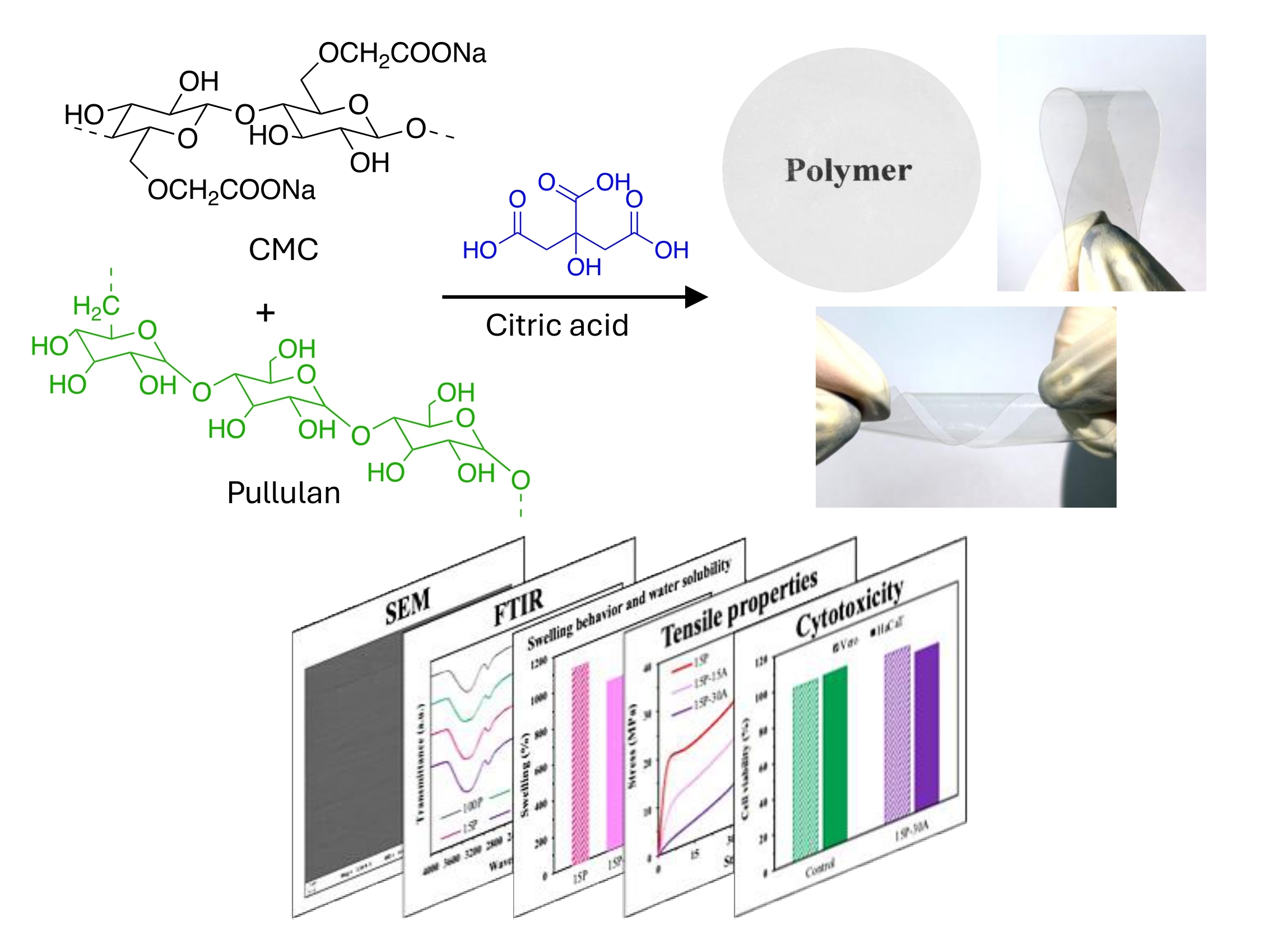Eco-Friendly Carboxymethyl Cellulose/Pullulan Blend Films: Preparation, Characterization and Proposed Applications
Keywords:
pullulan, carboxymethyl cellulose , biodegradable film , citric acid , packaging filmAbstract
Background and Objectives: In recent years, the heavy reliance on petroleum-based synthetic plastics particularly for single-use products has sparked significant environmental concern because of their long-lasting nature and resistance to breaking down naturally. Despite the functional advantages and convenience these materials offer, their accumulation in natural ecosystems has emerged as a critical ecological issue. Consequently, research efforts have increasingly shifted toward the development of sustainable, bio-based alternatives aimed at mitigating the environmental impact associated with conventional plastic use. Carboxymethyl cellulose (CMC) is a biodegradable polymer derived from naturally abundant cellulose, renowned for its excellent film-forming properties. However, its high-water solubility and inherent brittleness limit its practical utility in various applications. This study aims to enhance the water resistance and physical strength of CMC films through the citric acid crosslinking and the incorporation of pullulan. The modified films were subsequently evaluated for their structural integrity and biocompatibility to assess their potential applications.
Methodology: The modification of CMC-based films to enhance both water resistance and mechanical strength was accomplished through an approach involving the transformation of the linear structure of CMC into a three-dimensional network. This transformation employed citric acid as a non-toxic crosslinking agent, selected for its effectiveness in promoting crosslinking without compromising the biocompatibility of the resulting materials. Additionally, CMC/pullulan blending was performed to achieve uniform dispersion and to improve the overall properties of the films. Film formation was conducted using the solution casting method. The resultant crosslinked films combining CMC with pullulan, a polysaccharide known for its film-forming capabilities, were characterized to evaluate their properties. Characterization techniques included ATR-FTIR spectroscopy to assess the functional groups present in the films. Water solubility and swelling tests were conducted to evaluate the films’ resistance to water, a critical property for many applications. Tensile strength analysis was used to determine the mechanical performance of the films, indicating their ability to withstand stress without failure. Furthermore, SEM provided detailed insights into the films’ surface morphology. To ensure the biosafety of these innovative films, cell viability assays were conducted using African green monkey fibroblast cells (Vero) and immortalized human keratinocytes (HaCaT). These assays were crucial for evaluating potential cytotoxic effects, thereby confirming the films’ suitability for biomedical applications and other uses where biocompatibility is essential, such as drug delivery matrices.
Main Results: Citric acid crosslinking significantly improved the overall properties of CMC films, particularly enhancing their water resistance and mechanical strength. The study identified that incorporation of 15% citric acid yielded the most advantageous performance characteristics among the variations tested. This level of citric acid not only provided a network structure to the films but also contributed to their durability when exposed to moisture. In addition to citric acid, the incorporation of pullulan, a natural polysaccharide, further enhanced the flexibility of the CMC-based films. This addition was particularly beneficial as it did not compromise the optical transparency of the films, ensuring that they maintained clarity even with the modifications. The ability to retain transparency while improving flexibility is crucial for a range of applications, especially in fields such as packaging and biomedical materials. To confirm the successful formation of crosslinks and the compatibility of the polymeric components, characterization techniques such as ATR-FTIR and SEM were employed. The ATR-FTIR analysis demonstrated a new band associated with the covalent crosslinking through esterification reactions between the carboxylic acid groups of citric acid and the hydroxyl groups on the polymer chains. Meanwhile, the SEM images revealed a uniform and homogenous surface structure, providing further evidence of the effective interaction between the components. Importantly, the optimized film exhibited high cell viability for both Vero (95%) and HaCaT (90%) cell lines, highlighting its excellent biocompatibility. The positive results in these cell lines suggest that the modified CMC films are safe for biological applications. The combination of mechanical strength, flexibility, transparency, and biocompatibility makes the CMC based films, produced through citric acid crosslinking and pullulan incorporation, promising candidates for a wide range of future biomedical and packaging applications.
Conclusions: The incorporation of pullulan into crosslinked CMC matrices has proven to be a significant advancement in the field of biodegradable materials. This integration not only maintained the visual appeal and structural integrity of the films but also led to enhancements in their overall functional performance. The synergistic effects of combining CMC with pullulan resulted in the creation of innovative biodegradable films that possess improved characteristics. An optimal citric acid concentration of 15% was identified, as higher concentrations resulted in decreased mechanical performance. Incorporating 15% and 30% pullulan into the CMC matrix further enhanced the films' flexibility and tensile properties. These enhanced properties make the films well-suited for a broad range of applications. Their appealing visual appearance, combined with mechanical strength and flexibility, suggests that the crosslinked CMC/pullulan films can effectively meet consumer expectations while supporting environmental sustainability and reducing plastic waste.
References
Aleksanyan, K. V. (2023). Polysaccharides for biodegradable packaging materials: Past, present, and future (Brief Review). Polymers, 15(2), 451.
An, J. M., Shahriar, S. S., Hasan, M. N., Cho, S., & Lee, Y. K. (2021). Carboxymethyl cellulose, pluronic, and pullulan-based compositions efficiently enhance antiadhesion and tissue regeneration properties without using any drug molecules. ACS applied materials & interfaces, 13(14), 15992-16006.
Cheng, J., Gao, R., Zhu, Y., & Lin, Q. (2024). Applications of biodegradable materials in food packaging: A review. Alexandria Engineering Journal, 91, 70-83.
de Lima, G. F., de Souza, A. G., & Rosa, D. D. S. (2020, December). Nanocellulose as reinforcement in carboxymethylcellulose superabsorbent nanocomposite hydrogels. In Macromolecular Symposia, 394(1), 2000126.
Feng, Z., Chen, S., Ahmad, A., Chen, L., & Bai, W. (2022). Ultra-high molecular weight pullulan-based material with high deformability and shape-memory properties. Carbohydrate Polymers, 295, 119836.
Ghorpade, V. S., Dias, R. J., Mali, K. K., & Mulla, S. I. (2019). Citric acid crosslinked carboxymethylcellulose-polyvinyl alcohol hydrogel films for extended release of water soluble basic drugs.Journal of Drug Delivery Science and Technology, 52, 421-430.
Han, C., Cao, M., Yu, J., Wang, S., Zhou, X., Chen, Y., & Yang, F. (2023). Carboxymethyl cellulose-based composite polymer hydrogels cross-linked with epichlorohydrin and application for Cu (II) removal. ACS Applied Polymer Materials, 5(3), 2070-2078.
Kanatt, S. R., & Makwana, S. H. (2020). Development of active, water-resistant carboxymethyl cellulose-poly vinyl alcohol-Aloe vera packaging film. Carbohydrate polymers, 227, 115303.
Khabibi, K., Siswanta, D., & Mudasir, M. (2021). Preparation, characterization, and in vitro hemocompatibility of glutaraldehyde-crosslinked chitosan/carboxymethylcellulose as hemodialysis Membrane. Indonesian Journal of Chemistry, 21(5), 1120-1131.
Kumari, S., Rao, A., Kaur, M., & Dhania, G. (2023). Petroleum-Based Plastics Versus Bio-Based Plastics: A Review. Nature Environment & Pollution Technology, 22(3), 1111-1124.
Pratinthong, K., Punyodom, W., Jantrawut, P., Jantanasakulwong, K., Tongdeesoontorn, W., Sriyai, M., Panyathip, R., Thanakkasaranee, S., Worajittiphon, P., & Rachtanapun, P. (2024). Modification of a Carboxymethyl Cellulose/Poly (vinyl alcohol) Hydrogel Film with Citric Acid and Glutaraldehyde Crosslink Agents to Enhance the Anti-Inflammatory Effectiveness of Triamcinolone Acetonide in Wound Healing. Polymers, 16(13), 1798.
Priyadarshi, R., Kim, S. M., & Rhim, J. W. (2021). Pectin/pullulan blend films for food packaging: Effect of blending ratio. Food Chemistry, 347, 129022.
Reshma, G., Reshmi, C. R., & Shantikumar, V. N. (2020). Superabsorbent sodium carboxymethyl cellulose membranes based on a new cross-linker combination for female sanitary napkin applications. Carbohydrate Polymers, 248, 116763.
Roy, S., & Rhim, J.-W. (2021). Fabrication of cellulose nanofiber-based functional color indicator film incorporated with shikonin extracted from Lithospermum erythrorhizon root. Food Hydrocolloids, 114, 106566.
Sharmin, N., Rosnes, J. T., Prabhu, L., Böcker, U., & Sivertsvik, M. (2022). Effect of citric acid cross linking on the mechanical, rheological and barrier properties of chitosan. Molecules, 27(16), 5118.
Yildirim-Yalcin, M., Tornuk, F., & Toker, O. S. (2022). Recent advances in the improvement of carboxymethyl cellulose-based edible films. Trends in Food Science & Technology, 129, 179-193.
Zhang, M., Yang, B., Yuan, Z., Sheng, Q., Jin, C., Qi, J., Yu, M., Liu, Y., & Xiong, G. (2023). Preparation and performance testing of corn starch/pullulan/gallic acid multicomponent composite films for active food packaging. Food Chemistry, 19, 100782.
Zhang, X., Li, Z., Ji, R., Li, K., & Zhang, W. (2021). Preparation and characterization of pullulan/carboxymethyl cellulose/nano-TiO2 composite films for strawberry preservation. Food Biophysics, 16, 460-473.
Zhao, Y., Zhou, S., Xia, X., Tan, M., Lv, Y., Cheng, Y., Tao, Y., Lu, J., Du, J., & Wang, H. (2022). High-performance carboxymethyl cellulose-based hydrogel film for food packaging and preservation system. International Journal of Biological Macromolecules, 223, 1126-1137.

Downloads
Published
How to Cite
Issue
Section
License
Copyright (c) 2025 Faculty of Science, Burapha University

This work is licensed under a Creative Commons Attribution-NonCommercial-NoDerivatives 4.0 International License.
Burapha Science Journal is licensed under a Creative Commons Attribution-NonCommercial-NoDerivatives 4.0 International (CC BY-NC-ND 4.0) licence, unless otherwise stated. Please read our Policies page for more information



